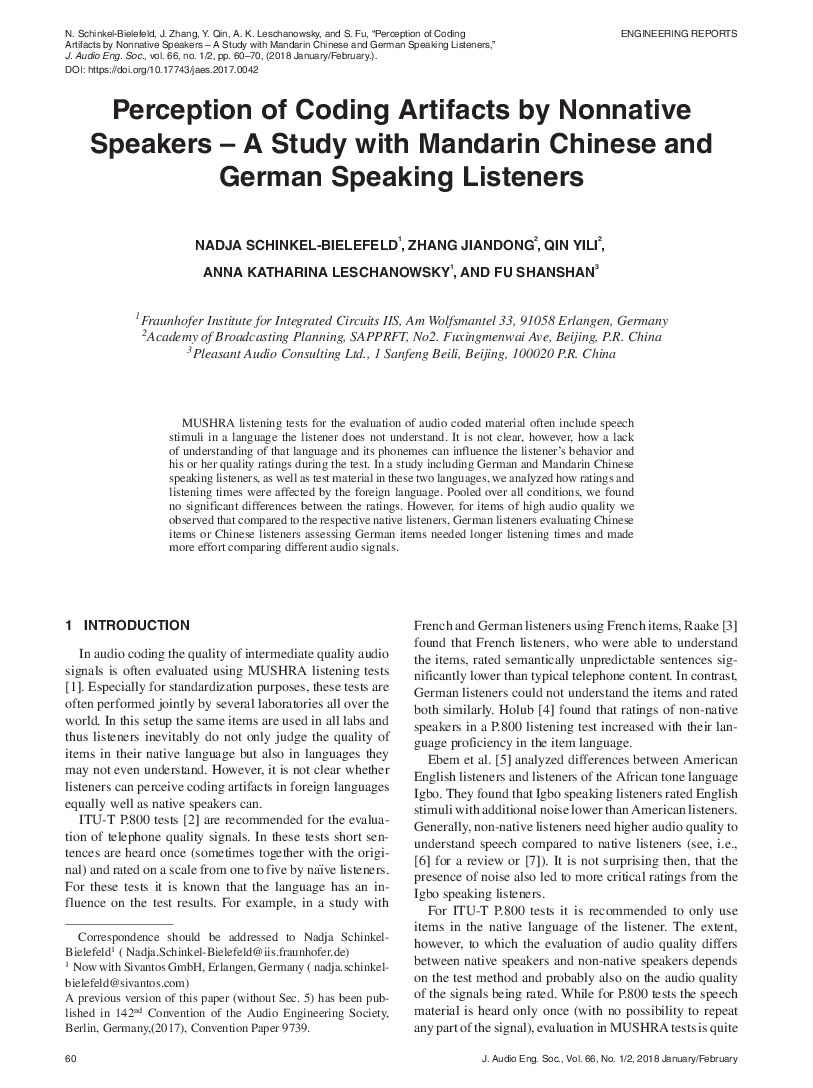Home / Publications / E-library page
You are currently logged in as an
Institutional Subscriber.
If you would like to logout,
please click on the button below.
Home / Publications / E-library page
Only AES members and Institutional Journal Subscribers can download
Using a standard protocol and sample audio cases to enhance reproducibility, tests of coding quality are often performed jointly by laboratories around the world. Multiple Stimuli with Hidden Reference and Anchor (MUSHRA) is one such standard protocol. The same audio samples are used in all labs and as a result, listeners inevitably are judging quality in either their native language or one that they do not understand. It is not clear if a lack of understanding the language and its phonemes can influence the listener’s perception and his or her quality ratings during the test. This study used German and Mandarin Chinese speaking listeners, as well as test material in these two languages. The authors analyzed how ratings and listening times were affected by the foreign language. When results were pooled over all conditions, no significant differences between the ratings were found. However, for items of high audio quality, it was observed that listeners needed more time to evaluate samples that were not their native language, and it took more effort to compare different audio signals. As in MUSHRA tests – contrary to ITU-T P.800 tests - listeners can compensate for any difficulty they may have in perceiving artifacts by more effort and longer listening times, it seems to be no problem to include nonnative listeners in these tests at the expense of making them slightly less efficient.
Author (s): Schinkel-Bielefeld, Nadja; Zhang, Jiandong; Qin, Yili; Leschanowsky, Anna Katharina; Fu, Shanshan
Affiliation:
Fraunhofer Institute for Integrated Circuits IIS, Erlangen, Germany; Academy of Broadcasting Planning, SAPPRFT, Beijing, P.R. China; Pleasant Audio Consulting Ltd., Beijing, P.R. China
(See document for exact affiliation information.)
Publication Date:
2018-01-06
Import into BibTeX
Permalink: https://aes2.org/publications/elibrary-page/?id=19376
(413KB)
Click to purchase paper as a non-member or login as an AES member. If your company or school subscribes to the E-Library then switch to the institutional version. If you are not an AES member Join the AES. If you need to check your member status, login to the Member Portal.

Schinkel-Bielefeld, Nadja; Zhang, Jiandong; Qin, Yili; Leschanowsky, Anna Katharina; Fu, Shanshan; 2018; Perception of Coding Artifacts by Nonnative Speakers - A Study with Mandarin Chinese and German Speaking Listeners [PDF]; Fraunhofer Institute for Integrated Circuits IIS, Erlangen, Germany; Academy of Broadcasting Planning, SAPPRFT, Beijing, P.R. China; Pleasant Audio Consulting Ltd., Beijing, P.R. China; Paper ; Available from: https://aes2.org/publications/elibrary-page/?id=19376
Schinkel-Bielefeld, Nadja; Zhang, Jiandong; Qin, Yili; Leschanowsky, Anna Katharina; Fu, Shanshan; Perception of Coding Artifacts by Nonnative Speakers - A Study with Mandarin Chinese and German Speaking Listeners [PDF]; Fraunhofer Institute for Integrated Circuits IIS, Erlangen, Germany; Academy of Broadcasting Planning, SAPPRFT, Beijing, P.R. China; Pleasant Audio Consulting Ltd., Beijing, P.R. China; Paper ; 2018 Available: https://aes2.org/publications/elibrary-page/?id=19376
@article{schinkel-bielefeld2018perception,
author={schinkel-bielefeld nadja and zhang jiandong and qin yili and leschanowsky anna katharina and fu shanshan},
journal={journal of the audio engineering society},
title={perception of coding artifacts by nonnative speakers - a study with mandarin chinese and german speaking listeners},
year={2018},
volume={66},
issue={1/2},
pages={60-70},
month={january},}
TY – paper
TI – Perception of Coding Artifacts by Nonnative Speakers - A Study with Mandarin Chinese and German Speaking Listeners
SP – 60 EP – 70
AU – Schinkel-Bielefeld, Nadja
AU – Zhang, Jiandong
AU – Qin, Yili
AU – Leschanowsky, Anna Katharina
AU – Fu, Shanshan
PY – 2018
JO – Journal of the Audio Engineering Society
VO – 66
IS – 1/2
Y1 – January 2018